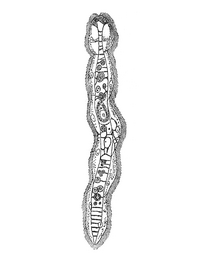Rhombozoa facts for kids
Quick facts for kids Rhombozoa/Dicyemida |
|
|---|---|
 |
|
| Scientific classification | |
| Kingdom: | |
| Superphylum: | |
| Phylum: |
Rhombozoa
van Beneden, 1876
|
| Families | |
|
|
The Rhombozoa, or Dicyemida, are a group of tiny parasites that live in the renal appendages of cephalopods.
Classification is controversial. They are probably a new phylum. Traditionally, dicyemids have been grouped with the Orthonectida in the Mesozoa. However, molecular phylogeny indicates that dicyemids may be more closely related to the roundworms.
Contents
Anatomy
Adult dicyemids range in length from 0.5 to 7 millimetres (0.020 to 0.276 in), and they can be seen through a light microscope. They have eutely: each adult individual of a given species has the same number of cells. Cell number is a useful identifying character.
The organism's structure is simple: a single axial cell is surrounded by a jacket of twenty to thirty ciliated cells.
Life cycle
Dicyemids exist in both asexual and sexual forms. The asexual forms are found in juvenile and immature hosts; and the sexual forms in mature hosts.
The asexual stage is termed a nematogen; it produces vermiform (worm-like) larvae in the axial cell. These mature through direct development to form more nematogens. Nematogens proliferate in young cephalopods, filling the kidneys. Later, as the hosts mature, sexual forms called rhombogens are formed. They are hermaphrodites, with gonads of both sexes. The rhombogens self-fertilise, and later release larvae.
Images for kids
See also
 In Spanish: Rombozoos para niños
In Spanish: Rombozoos para niños


